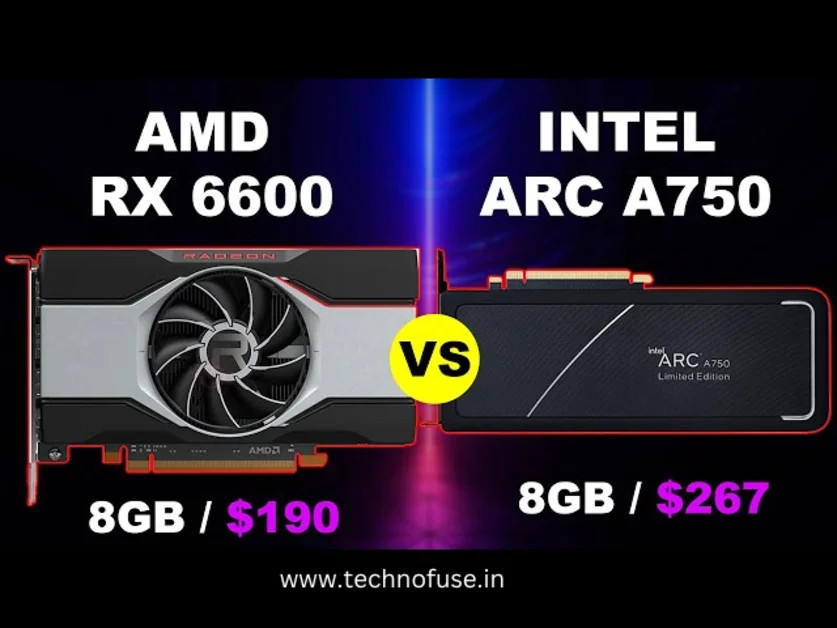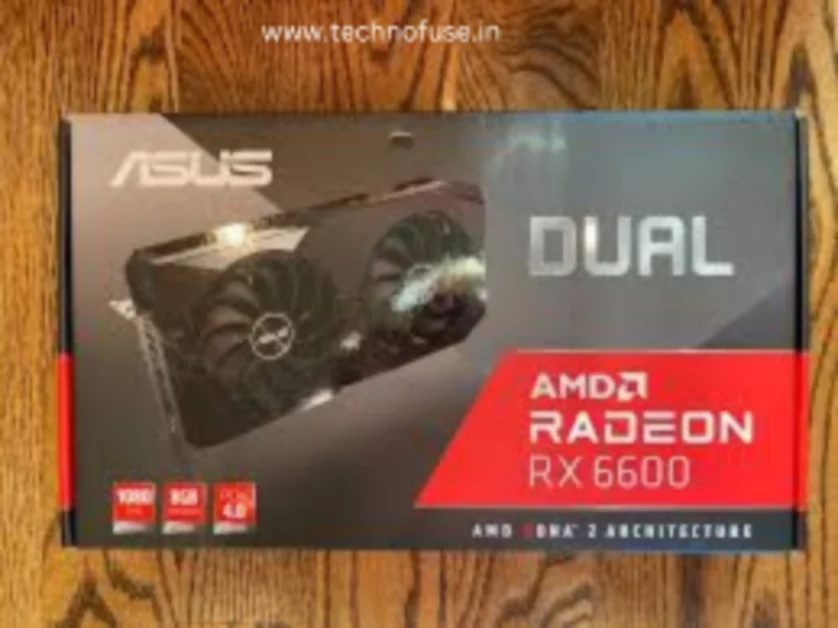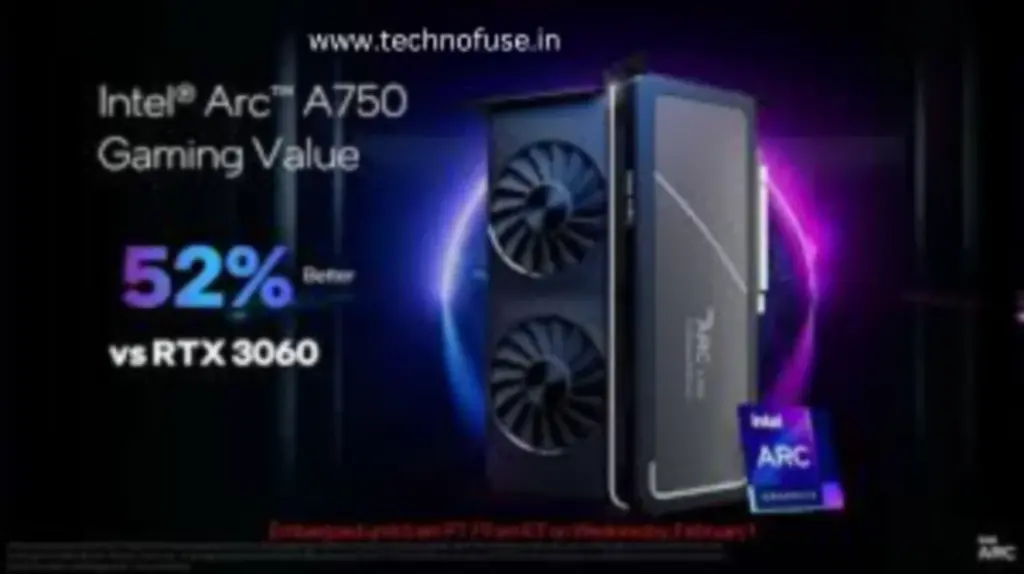Intel Arc A750 vs. AMD Radeon RX 6600: A Comprehensive Comparison: The world of tech is a pulsating labyrinth of innovation, and within this labyrinth, few segments excite and perplex as much as the race for graphics superiority. For tech enthusiasts and PC gamers, the choice of a graphics card is more than utility – it’s an investment in the heart of their rig, defining the pixels that power their passions. Today, we dissect this high-stakes realm by pitting two formidable contenders against each other: the Intel Arc A750 and the AMD Radeon RX 6600.
Performance Comparison

Specifications and Features
The foundation of any graphics card battle is laid with specifications, and here the Intel Arc A750 and AMD Radeon RX 6600 are stacked to the brim. The Arc A750 arrives with 4,096 cores, a base clock of 2,150 MHz, and a boost clock of 3,900 MHz. On the storage front, Intel brings 12 GB of GDDR6 memory across a 192-bit interface. Meanwhile, AMD’s Radeon RX 6600 boasts 2,048 stream processors, a base clock of 2,459 MHz, and a boost clock of 2,874 MHz. With 8 GB of GDDR6 VRAM riding a 128-bit bus, AMD’s offering seems to tip the scales in favor of higher clock speeds.
Benchmark Tests and Performance Analysis
In the crucible of benchmark tests, the Arc A750 and Radeon RX 6600 stand toe-to-toe, each boasting significant prowess in their attempts to outshine the other. Intel’s Arc A750 proves its mettle by delivering in the region of 12 TFLOPs of raw compute power, placing it on even ground with its rival. However, it is the Radeon RX 6600 that snatches the lead in some areas, particularly in rasterization performance, carving a niche for itself in the competitive 1080p gaming market. [Intel Arc A750 vs. AMD Radeon RX 6600]
Gaming Experience and Frame Rates Comparison
Gamers are a passionate lot, lovingly quibbling over the minutiae of frame rates and texture detail. When it comes to their experience, every frame counts. In direct gaming experience comparisons, the Radeon RX 6600 is reported to offer smoother gameplay, especially in high-action, dynamic environments. The Arc A750 may appeal to those looking for consistent frame rates and solid performance across a range of titles. The choice between these two then becomes a nuanced decision, hinging on gaming preferences and system configuration.
Price and Value Proposition

Cost Analysis
Beyond the numbers on the spec sheet, the price tag plays a pivotal role. The Intel Arc A750 is competitively priced, catering to a discerning base that values the newest entrant from Intel. On the flip side, the AMD Radeon RX 6600 offers a compelling package at a price point that is hard to ignore, particularly for budget-conscious consumers. Here, AMD’s aggressive pricing strategy is clear, positioning the RX 6600 as an attractive mid-range option.
Value for Money Comparison
It’s not just about the cost; it’s about what value the graphics card adds to the build. AMD’s RX 6600 packs high value for money by providing strong performance at its price. The Arc A750, while justifying its cost with Intel’s entry into the market, may leave some users wanting more in terms of sheer performance for the dollar.
Technological Advancements

Unique Technologies and Innovations
Both contenders bring their heavyweight technologies to the ring. Intel Arc A-series comes with XeSS (Super Sampling) technology, aimed at improving in-game visual quality and performance. Meanwhile, the AMD Radeon RX 6600 boasts FidelityFX Super Resolution, a similar technology that leverages cutting-edge upscaling methods. Each approach underlines a commitment to pushing the envelope on visual fidelity, albeit with a twist in implementation that could sway the pack in favor of one’s build style and preferences. [Intel Arc A750 vs. AMD Radeon RX 6600]
Future-Proofing and Upgrade Potential
Future-proofing one’s system is a predominant concern. Here, looking at potential upgrades and longevity, the choice becomes more profound. The Intel Arc A750 introduces consumers to the brand’s promise, hinting at future iterations and the software support that could solidify its place in the market. On the other hand, AMD’s Radeon RX 6600 integrates seamlessly into the robust ecosystem the company has forged with past products, ensuring a strong base for the future.
User Experience and Reviews
Community Feedback
In the mosaic of user feedback, the narrative is multifaceted. Users point out the Intel Arc A750’s promising future, acknowledging its early hiccups and lauding its trajectory. Simultaneously, the Radeon RX 6600 garners acclaim for its immediate impact, with gamers attesting to its performance in today’s popular titles.
Pros and Cons
Scrutinizing strengths and weaknesses offers valuable insights. The Intel Arc A750’s strength lies in its innovative Xe architecture, with potential for broader software optimization. Yet, it is critiqued for teething issues and a learning curve for the brand. Conversely, the Radeon RX 6600 is celebrated for its out-of-the-box performance but faces criticism for falling behind in ray tracing applications.
SEO Optimization
In an article that’s geared to be both a resource and a guide for the informed consumer, SEO optimization is key. Mentioning this comparison in contexts where graphics cards are discussed, and weaving in keywords like “best graphics cards 2022,” “Arc A750 vs. RX 6600 benchmarks,” and “AMD vs. Intel graphics cards” will serve to elevate the article’s search rankings. Employing relevant meta tags, high-quality images with descriptive alt text, and structured data will additionally enhance the post’s visibility.
Conclusion
The Intel Arc A750 and AMD Radeon RX 6600 signify the continued evolution within the domain of graphics cards. The decision between these two stalwarts is not a matter of black and white but a nuanced interplay of system requirements, performance expectations, budget constraints, and brand affiliation. It’s about what graphic narrative resonates with you, the user. For some, Intel’s new entrant will be a welcome segue into a future that promises performance through adaptability. For others, AMD’s RX 6600 ticks the boxes of immediate satisfaction and stable performance. What remains constant is the competitive push these innovations create, enriching the market and, inevitably, the gaming experience. [Intel Arc A750 vs. AMD Radeon RX 6600]
For more in-depth analysis and tech comparisons, continue your exploration. Deciphering the tech labyrinth may be complex, but with each comparison, the path to informed decisions becomes clearer.
Frequently Asked Questions
Q: Can I use the Intel Arc A750 for professional video editing?
A: Yes, the Intel Arc A750 is well-suited for professional video editing tasks. Its architecture provides substantial support for rendering and encoding processes, making it a robust choice for content creators.
Q: How does AMD Radeon RX 6600 perform in ultra-high-definition gaming?
A: The AMD Radeon RX 6600 is designed to handle ultra-high-definition gaming efficiently, offering immersive experiences at 1080p and good performance at 1440p. However, for 4K gaming, it might struggle with very demanding titles on the highest settings.
Q: Are these cards compatible with all types of motherboards?
A: Both the Intel Arc A750 and AMD Radeon RX 6600 use PCIe 4.0, which is backward compatible with PCIe 3.0 slots found on most modern motherboards. However, ensure your motherboard has the correct slot type and adequate space for the GPU.
Q: What is the power supply requirement for these graphics cards?
A: The Intel Arc A750 and AMD Radeon RX 6600 have different power supply requirements. Generally, a power supply of at least 650 watts is recommended for the Arc A750, while the Radeon RX 6600 can often operate efficiently on a 550-watt power supply. Check specific manufacturer recommendations for the best results.
Q: Can I overclock the AMD Radeon RX 6600 to match higher-end GPU performance?
A: Overclocking the AMD Radeon RX 6600 can yield performance gains, potentially bringing it closer to higher-end GPUs in some scenarios. However, the extent of performance improvement varies and overclocking should be done cautiously to avoid overheating or hardware damage.
Q: Is ray tracing performance comparable between these two cards?
A: Ray tracing is a demanding technology, and performance varies depending on the game and settings. The Intel Arc A750 offers competitive ray tracing capabilities thanks to its Xe HPG architecture. The AMD Radeon RX 6600, with its RDNA2 architecture, also supports ray tracing, though performance may differ in intensively demanding situations.
